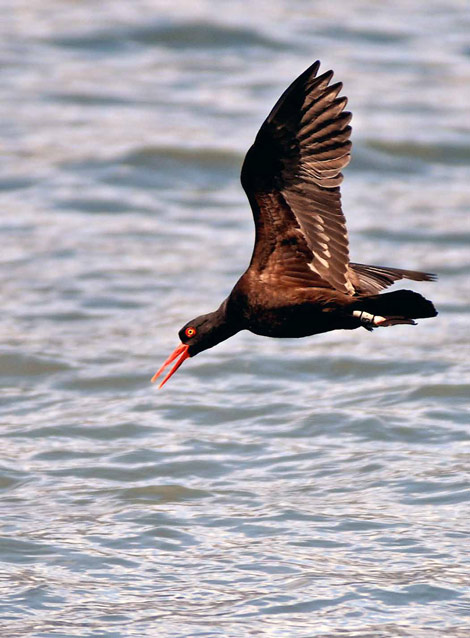
K. Thoreson
Approach a rocky secluded beach in Kenai Fjords National Park (Kenai Fjords) and you will likely be noisily greeted by a large black shorebird with a long, bright red bill (Figure 1). During the summer months, black oystercatchers(Haematopus bachmani) defend their territories of beach between low tide and the upper coastline, where they forage, lay eggs, and raise young. Explore the gravel beaches of Kenai Fjords and you may have an opportunity to watch black oystercatchers use their long flattened bill to pry open mussels or wrest limpets off rocks exposed at low tide or to find one of their well camouflaged nests, a shallow depression in the gravel containing two or three speckled eggs.
While the black oystercatcher’s reliance on a narrow band of shoreline for feeding and breeding makes them conspicuous and easy to observe, it also makes them vulnerable to both natural and human disturbances that occur within the nearshore ecosystem (Figure 2). Flooding destroys nests during extreme high tides and storm surges, and predators such as black bears, mink, and common ravens eat eggs and chicks they find while hunting along the shoreline. In Alaska, the Exxon Valdez oil spill killed up to 20 percent of the breeding population in the spill area and lingering oil left on beaches continued to affect oystercatchers for years afterwards (Andres 1994; Sharp et al. 1996; Andres 1997; and Weins et al. 2004).
Frequently, human development and recreation is concentrated in coastal areas and oystercatchers may be particularly vulnerable to human-caused disturbance and habitat loss. With only 10,000 individuals scattered along the Pacific coastline between the Aleutian Islands and Baja Mexico, black oystercatchers have one of the smallest population sizes among shorebirds in North America (Tessler et al. 2014; Brown et al. 2001). As a consequence of their small population size and dependence on coastal habitats, black oystercatchers are recognized as a species of conservation concern by federal and state agencies and have been the focus of various research efforts including a number of studies at Kenai Fjords (US Fish and Wildlife Service 2008; Tessler et al. 2010, 2014 and Bodkin 2011).
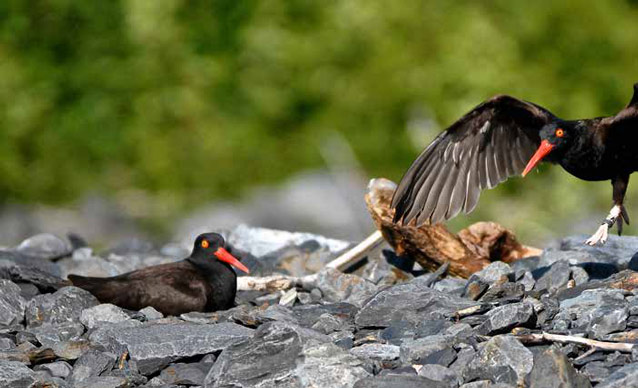
NPS Photo / K. Thoreson
Increasing use of coastal areas by visitors kayaking and boating in Kenai Fjords prompted the park to initiate research and monitoring projects to examine possible negative impacts to black oystercatchers (Tetreau 2004; Morse 2006). Researchers examined the ability of black oystercatchers to hatch eggs and successfully raise chickas(Figure 3) in relation to the level of recreational disturbance at nest areas. While breeding success was generally low, it was comparable to success rates observed in other studies of black oystercatchers (Andres and Falxa 1995; Murphy and Mabee 2000; and Hazlitt 2001) and did seem to be affected by visitor disturbance. In Kenai Fjords, as in other areas where black oystercatchers nest, predators were the primary cause of egg mortality. Because of the nature of their research, Morse et al. (2006) were not able to identify the primary predators responsible for eating eggs and chicks; however, they noted that the suite of potential nest predators in the park was extensive.
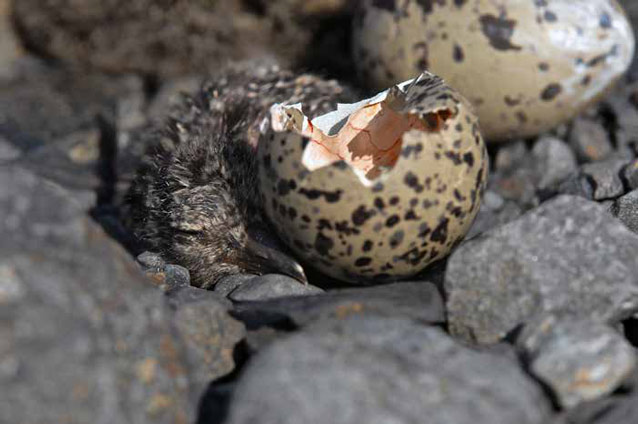
NPS Photo / K Thoresen
Recent research utilized remote camera technology at black oystercatcher nests to identify sources of disturbance and mortality to eggs, chick, and adults (Figure 4) (Robinson and Phillips 2013; Stark et al. 2015). Cameras captured images of oystercatcher egg mortality due to predation by common raven, black bear, and domestic dog (Figure 5). A nest camera also photographed a peregrine falcon depredating an oystercatcher brood before they were able to leave the nest scrape. Though peregrine falcons have been identified as predators of black oystercatchers (Bechaver and Gehrig 2011; Tessler et al. 2010), this was the first evidence of falcons preying on black oystercatchers in the Kenai Fjords area (Figure 6).
To continue to monitor black oystercatcher populations in the park, Kenai Fjords managers in cooperation with Southwestern Alaska Inventory and Monitoring Network (SWAN) staff developed a long-term monitoring program to evaluate trends in breeding population densities, nesting success and diet (Bodkin 2011; Coletti et al. 2014). Black oystercatchers prey on a variety of intertidal invertebrates that they bring back to their nest areas to feed chicks.
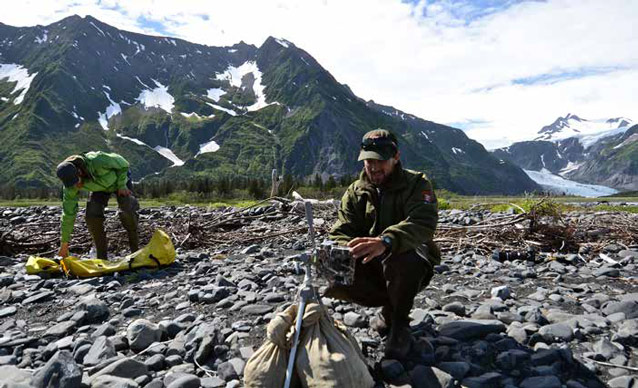
NPS Photo / K Thoresen
To examine oystercatcher diet, researchers collect the shells of prey items left around nest sites, which provides estimates of the relative abundance and size classes of invertebrates that adults are feeding their chicks. Determining what black oystercatchers eat is important because their consumption of ecologically important invertebrates, such as limpets and mussels, can have cascading impacts on the structure of intertidal communities. Limpets are herbivores that graze on algae, and when, as a consequence of oystercatcher foraging, limpets are removed from a system it may result in increased algal populations. The impact black oystercatchers have as top level consumers in structuring nearshore ecosystems has led them to be classified as “keystone” species (Power et al. 1996), a species whose influence is disproportionate to its abundance. The monitoring program has found that three species of limpets and the Pacific blue mussel were the prey items most frequently found at black oystercatcher nests between 2007 and 2012 and that oystercatchers were eating mussels and limpets that were larger in size than those generally available (Figure 7) (Coletti et al. 2014).
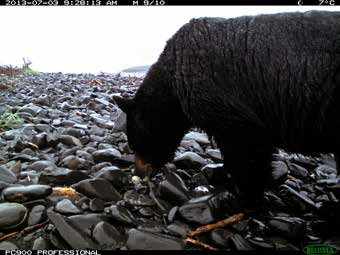
NPS Photo
The monitoring program has provided some important insight about the black oystercatcher’s role as a keystone predator in Kenai Fjords; however, using the collection of prey remains to evaluate diet may have some limitations. Although a widely used method for estimating diet composition of chicks, these estimates may be subject to biases based on prey body type, nesting habitat, and collection date. To determine the accuracy of monitoring methods, researchers initiated studies using direct foraging observations and stable isotope analyses to further examine black oystercatcher diet (Carney 2013; Robinson et al. in prep).
Using stable isotopes, Carney found that in the spring and early summer adult black oystercatchers were eating a diet with a ratio of mussels and limpets that corresponded to previous observation-based studies in Alaska. In 2013-14, researchers observed black oystercatcher parents feeding chicks, and captured chicks to collect samples for stable isotope analyses and examine growth rates (Figure 8). They compared the results of direct observations and stable isotope analyses to those obtained through the more traditional method of collecting prey remains and found that prey collection over-estimated limpet abundance, under-estimated the proportion of barnacles, and failed to detect soft bodied prey such as worms in the diet (Robinson et al. in prep).
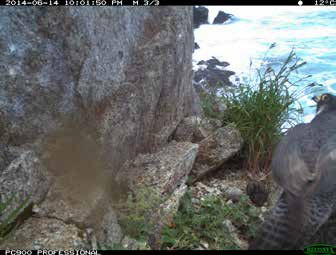
NPS Photo
Black oystercatchers play a vital role in the nearshore ecosystem and a visit to the Kenai Fjords coast wouldn’t be the same without their colorful presence and the sound of their piping call. While Kenai Fjords will continue to monitor the health of and support research on black oystercatcher populations, visitors play a crucial role in ensuring the long-term persistence of these birds in the park. Keeping a safe distance from nests and not allowing dogs to run free on beaches are two steps everyone can take to protect black oystercatchers wherever they live.
aps-14-2-4-7
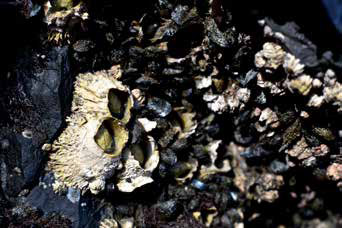
NPS Photo
References
Andres, B. 1994.
The effects of the Exxon Valdez oil spill on black oyster- catchers breeding in Prince William Sound, Alaska. Exxon Valdez Oil Spill State/Federal Natural Resource Damage Assessment Final Report (Bird Study Number 12/Restora tion Study Number 17). Anchorage: U.S. Fish and Wildlife Service.
Andres, B. 1997.
The Exxon Valdez oil spill disrupted the breeding of black oystercatchers. Journal of Wildlife Management. 61: 1322–1328.
Andres, B., and G. Falxa. 1995.
The Birds of North America Online. Ed. A. Poole. Black oystercatcher (Haematopus bachmani). Ithaca: Cornell Lab of Ornithology.
Bechaver, C., and J. Gehrig. 2011.
Biological monitoring at Aiktak Island, Alaska in 2011. AMNWR 2012/01. Homer: U.S. Fish and Wildlife Service.
Bodkin, J. 2011.
SOP for monitoring black oystercatchers—version 1.1: Southwest Alaska Inventory and Monitoring Network. Natural Resource Report NPS/SWAN/NRR-2011/391. Fort Collins: National Park Service.
Brown, S., C. Hickey, B. Harrington, and R. Gill, eds. 2001.
The U.S. Shorebird Conservation Plan. 2nd ed. Manomet, MA: Manomet Center for Conservation Sciences.
Carney, B. 2013
Diet Patterns of Black Oystercatchers (Haematopus bachmani) in the Northern Gulf of Alaska. Anchorage: University of Alaska Anchorage.
Coletti, H., T. Dean, K. Kloecker and B. Ballachey. 2014.
Nearshore marine vital signs monitoring in the southwest Alaska network of national parks: 2012. Natural Resource Technical Report NPS/SWAN/NRTR—2014/843. Fort Collins: National Park Service.
Hazlitt, S. 2001.
Territory quality and reproductive success of black oyster- catchers in British Columbia. Wilson Bulletin. 113:404–409.
Morse, J., A. Powell, and M. Tetreau. 2006.
Productivity of black oystercatchers: effects of recreational disturbance in a national park. Condor. 108: 623–633.
Murphy, S., and T. Mabee. 2000.
Status of black oystercatchers in Prince William Sound, Alaska, nine years after the Exxon Valdez oil spill. Water birds. 23:204–213.
Power, M, et al. 1996.
Challenges in the quest for keystones. BioScience. 46:609 620
Robinson, B., and L. Phillips. 2013.
Black oystercatcher chick diet and provisioning: 2013 an nual report. Natural Resource Data Series NPS/KEFJ/NRDS – 2013/588. Fort Collins: National Park Service.
Robinson, B., L. Phillips, H. Coletti, and A. Powell. In prep.
Are prey remains reliable indicators of chick diet? Implica tions for long-term monitoring of black oystercatchers.
Sharp, B., M. Cody, and R. Turner. 1996.
Effects of the Exxon Valdez oil spill on the black oyster- catcher. American Fisheries Society Symposium. 18:758 1996.
Stark, S., B. Robinson, and L. Phillips. 2015.
Black oystercatcher chick diet and provisioning: 2013 an nual report. Natural Resource Data Series NPS/KEFJ/NRDS— 2015/749. Fort Collins: National Park Service.
Tessler, D., J Johnson, B. Andres, S. Thomas, and R. Lanctot. 2010.
Black Oystercatcher (Haematopus bachmani) Conservation Action Plan. Version 1.1. International Black Oystercatcher Working Group, Alaska Department of Fish and Game, An chorage, Alaska, U.S. Fish and Wildlife Service, Anchorage, Alaska, and Manomet Center.
Tessler, D., J. Johnson, B. Andres, S. Thomas, and R. Lanctot. 2014.
A global assessment of the conservation status of the black oystercatcher (Haematopus bachmani). International Wader Studies. 20: 83–96.
Tetreau, M. 2004.
Monitoring nesting success of the black oystercatcher. Alas ka Park Science. 3:30. Anchorage: National Park Service.
U.S. Fish and Wildlife Service. 2008.
Birds of Conservation Concern 2008. United States De partment of Interior, Fish and Wildlife Service, Division of Migratory Bird Management, Arlington, Virginia.
Weins, J., R. Day, S. Murphy, and K. Parker. 2004.
Changing habitat use by birds after the Exxon Valdez oil spill, 1989-2001. Ecological Applications. 14:1806-1825.
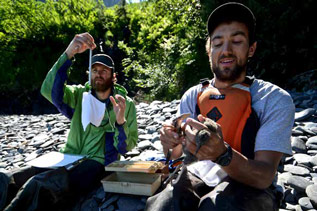
NPS Photo / K Thoresen
Part of a series of articles titled Alaska Park Science - Volume 14 Issue 2: Birds of Alaska's National Parks.
Last updated: August 18, 2017
